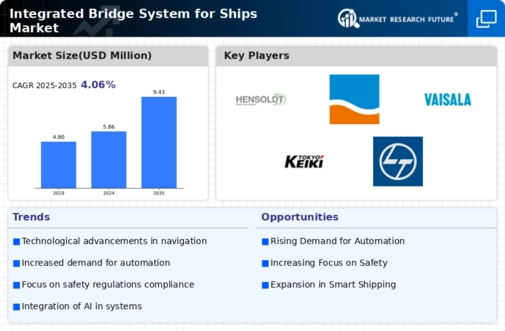Top Industry Leaders in the Integrated Bridge System for Ships Market

The competitive landscape of the Integrated Bridge System (IBS) for Ships market is crucial in the maritime industry, providing vessels with a comprehensive navigation and control solution. Key players in this market deploy various strategies to navigate challenges and meet the increasing demand for advanced integrated bridge systems.
Key Players:
Northrop Grumman Corporation (US)
Rolls-Royce plc (UK)
Wärtsilä (Finland)
Kongsberg Maritime AS (Norway)
Raytheon Technologies Corporation (US)
L-3 Mapps (UK)
HENSOLDT (Germany)
Alphatron Marine B.V. (Netherlands)
RH Marine (Netherlands)
GEM Elettronica (Italy)
Vaisala (Finland)
OSI MARITIME SYSTEMS (Canada)
ABB Ltd (Switzerland)
Furuno Electric Co. Ltd. (Japan)
TOKYO KEIKI (Japan)
Danelec Marine (Denmark)
Consilium (Sweden)
Marine Technologies LLC (US)
Praxis Automation Technology B.V. (Netherlands)
Norris Group GmbH (Germany)
Mackay Communications Inc. (US)
PRIME MOVER CONTROLS INC. (Canada)
PC Maritime (UK)
LARSEN & TOUBRO LIMITED (India)
Strategies Adopted:
The Integrated Bridge System for Ships market deploy strategic initiatives to address the evolving needs of the maritime industry. Notable strategies include continuous investment in research and development (R&D), diversification of product portfolios, strategic partnerships, and a focus on enhancing user interface and data integration. Kongsberg, for instance, emphasizes R&D investments to enhance its integrated bridge system technologies, showcasing a commitment to technological advancement. Strategic collaborations between Wärtsilä and shipbuilders aim to optimize integrated bridge system implementations for specific vessel types, demonstrating a cooperative approach to addressing the diverse needs of the maritime sector.
Market Share Analysis:
The Integrated Bridge System for Ships market is influenced by factors such as system reliability, user interface design, adaptability to different vessel types, pricing competitiveness, and the ability to provide comprehensive solutions for various maritime applications. Companies excelling in delivering high-quality, technologically advanced integrated bridge systems, ensuring compliance with stringent maritime standards, and offering solutions adaptable to diverse vessels are strategically positioned to capture a larger market share. Establishing strong relationships with shipbuilders, maritime operators, and participating in industry collaborations are crucial for maintaining a competitive edge in this sector.
News & Emerging Companies:
The Integrated Bridge System for Ships market has witnessed the emergence of new companies aiming to address the growing demand for innovative and user-friendly bridge systems. Emerging entrants, such as Tokyo Keiki Inc. and Radio Zeeland DMP B.V., have gained attention for their focus on introducing advanced integrated bridge system technologies that cater to the specific needs of modern maritime operations. These emerging companies contribute to the market by introducing fresh perspectives and agile approaches to address the evolving requirements of navigation and control in the maritime sector.
Industry Trends:
The Integrated Bridge System for Ships market underscores ongoing investment trends, with a strong emphasis on improving system capabilities, enhancing user experience, and addressing the challenges of data integration. Companies are investing significantly in the development of integrated bridge system technologies with increased automation, improved data analytics, and adaptability to emerging technologies such as artificial intelligence. Investments in addressing the challenges of data integration reflect the industry's response to the growing need for seamless navigation and control in modern maritime operations. Enhanced features, including augmented reality displays and predictive analytics, are a focus to enhance overall situational awareness and operational efficiency.
Competitive Scenario:
The Integrated Bridge System for Ships market is marked by intense competition among established players and the entry of innovative newcomers. With the maritime industry becoming increasingly reliant on advanced bridge systems for safe and efficient navigation, companies aim to differentiate themselves by offering comprehensive solutions that address the challenges of modern maritime operations. Established players focus on refining their integrated bridge system designs, expanding their market presence through strategic collaborations with shipbuilders and maritime operators, and staying informed about emerging technologies and regulatory requirements. The entry of emerging companies adds dynamism to the market, fostering an environment of continuous improvement and responsiveness to the changing demands of the maritime industry.
Recent Development
The Integrated Bridge System for Ships market witnessed a significant development as Kongsberg Gruppen ASA announced the successful implementation of its advanced integrated bridge system on a new class of commercial vessels. The implementation showcased the system's enhanced capabilities, including improved user interface and advanced data integration, aligning with the maritime industry's drive towards increased automation and digitalization. This development highlights Kongsberg's commitment to advancing integrated bridge system technologies and reinforces its position as a key player in the market. The successful implementation is expected to contribute to the overall enhancement of vessel navigation and control, offering improved efficiency and safety features. The announcement reflects the industry's continuous efforts to evolve and provide cutting-edge solutions that address the challenges posed by the dynamic maritime landscape, emphasizing the importance of advanced integrated bridge system technologies in shaping the future of navigation and control in the maritime sector.


